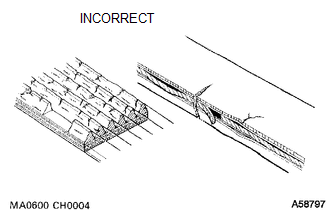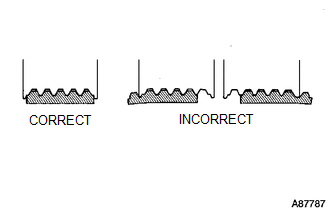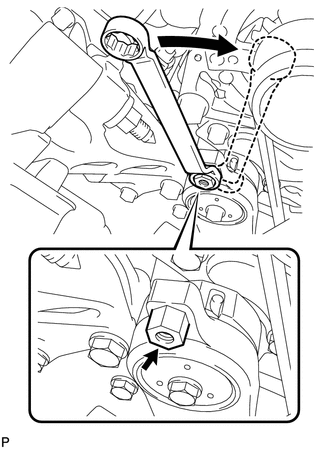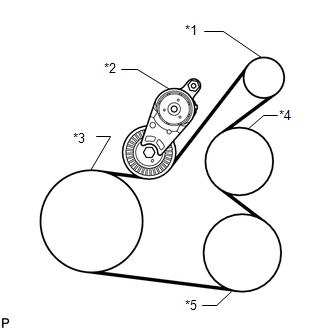Toyota Venza: Drive Belt
Components
COMPONENTS
ILLUSTRATION
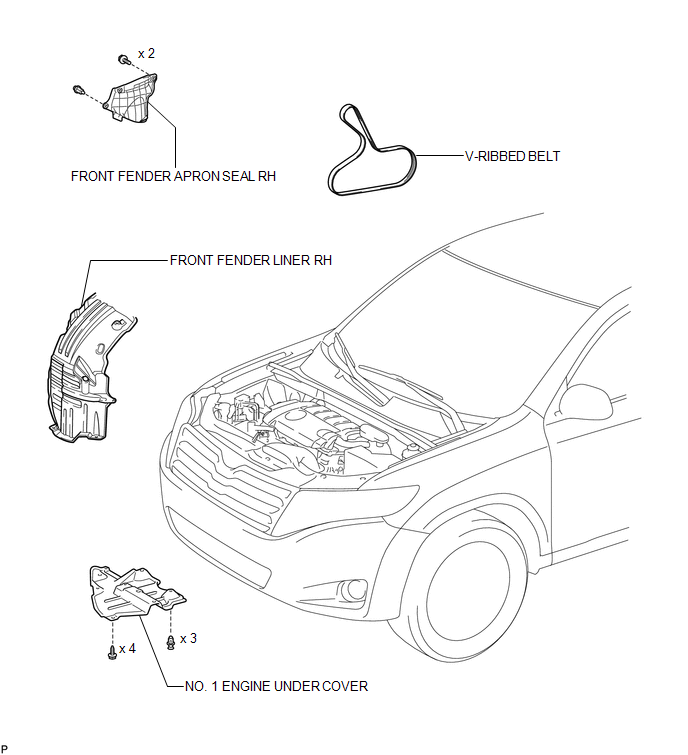
On-vehicle Inspection
ON-VEHICLE INSPECTION
PROCEDURE
1. INSPECT V-RIBBED BELT
|
(a) Check the belt for wear, cracks or other signs of damage. If any of the following defects is found, replace the V-ribbed belt.
|
|
|
(b) Check that the belt fits properly in the ribbed grooves. HINT: Check with your hand to confirm that the belt has not slipped out of the groove on the bottom of the pulley. If it has slipped out, replace the V-ribbed belt. Install a new V-ribbed belt correctly. |
|
2. INSPECT V-RIBBED BELT TENSIONER ASSEMBLY
(a) Check that nothing gets caught in the tensioner by turning it clockwise and counterclockwise.
If a malfunction exists, replace the V-ribbed belt tensioner.
Removal
REMOVAL
PROCEDURE
1. REMOVE FRONT WHEEL RH
2. REMOVE NO. 1 ENGINE UNDER COVER
3. SEPARATE FRONT FENDER LINER RH
4. REMOVE FRONT FENDER APRON SEAL RH
.gif)
5. REMOVE V-RIBBED BELT
|
(a) Attach a wrench to the hexagonal portion of the belt tensioner as shown in the illustration, rotate the belt tensioner clockwise, and remove the V-ribbed belt. |
|
Installation
INSTALLATION
PROCEDURE
1. INSTALL V-RIBBED BELT
|
(a) Set the V-ribbed belt onto each part as shown in the illustration except the water pump pulley. Text in Illustration
|
|
(b) Loosen the V-ribbed belt by turning the belt tensioner clockwise.
(c) Set the V-ribbed belt onto the water pump pulley.
NOTICE:
Make sure that the belt is attached to each pulley. In particular, make sure that the belt is securely fitted into the grooves of the crankshaft pulley.
2. INSTALL FRONT FENDER APRON SEAL RH
.gif)
3. INSTALL FRONT FENDER LINER RH
4. INSTALL NO. 1 ENGINE UNDER COVER
5. INSTALL FRONT WHEEL RH
Torque:
103 N·m {1050 kgf·cm, 76 ft·lbf}
 Installation
Installation
INSTALLATION
CAUTION / NOTICE / HINT
HINT:
Perform "Inspection After Repair" after replacing the camshaft, No. 2 camshaft,
camshaft timing gear assembly, camshaft timing exhaust gear as ...
 Engine
Engine
...
Other materials about Toyota Venza:
Speaker Output Short (B15C3)
DESCRIPTION
This DTC is stored when a malfunction occurs in the speakers.
DTC No.
DTC Detection Condition
Trouble Area
B15C3
A short is detected in the speaker output circuit
...
Vehicle Speed Signal Error (Test Mode DTC) (C2191/91)
DESCRIPTION
The tire pressure warning ECU receives a vehicle speed signal from the combination
meter. This DTC is stored upon entering signal check mode (test mode), and cleared
when a vehicle speed signal of 20 km/h (12 mph) is detected for 3 seconds or ...
System Description
SYSTEM DESCRIPTION
1. DESCRIPTION OF SYSTEM
(a) Each tire pressure warning valve and transmitter is equipped with a tire
pressure sensor and a transmitter and is installed in each tire and wheel assembly.
The sensor measures the tire pressure. The measur ...
0.1584

